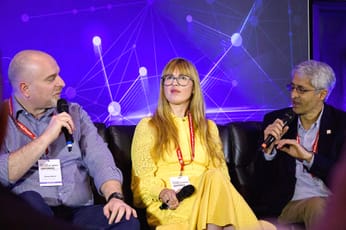Le Web 3 '07: Playin' Games

The presentation that most people have mentioned to me as changing the way they think about something was Joi Ito’s talk on gaming. Me? I loved it, but then the talk was about World of Warcraft, and I’m a player. (“Hi, my name’s Adam Tinworth and I’m a night elf druid“).
Ito started of with a crowd-pleasing assault on the perception of gaming in society as a whole.
“We still say ‘addicted to games’,” he said. “We don’t say ‘addicted to church’ if people go to church every week.”
He’s quite right – it’s a non-useful way of viewing the situation. It’s rooted, he explained, in the way we use language around the internet, at least in the English-speaking world. We have this word “cyberspace”, which implies a separation between the online world and the “real” world. We have “real” friends and “virtual” friends.
“For kids the internet is ubiquitous. It’s not something you log into or out of,” said Ito. And, to them, gaming is certainly not the “masturbation-like activity” many adults seem to view it as. For one thing, people are often interacting with existing friends in the game…
So what is it?
Well, as an example he showed a video of a Molten Core raid, a challenging adventure in the game that requires 40 people to complete, and usually takes many hour spread over a week. (To the WoW players out there, sorry for the simplistic description and yes, I know that it’s an old skool raid now Burning Crusade has been with us for the best part of a year, but I guess Ito’s been giving variations of this presentation for a while now.)
Co-ordinating 40 people, and getting the right balance of classes to achieve the challenges of the game is almost like a ball, a dance, he suggested. “A 40-man raid can unravel in minutes if all the emotional tension isn’t co-ordinated,” he said. “MBAs suck at this, because they’re no good at listening in these games.” People in service industries are the best, he suggested, because they’re used to managing through persuasion, rather than coercion.
However (and this is the good bit, folks), he suggested that you need to look at these games in terms of similes or metaphors. A simile of office life would just be the office recreated in detail online. A metaphor of it would be an environment where everything is different, bar one thing – in this case, the management and communication skills needed to succeed.

The open voice channels guilds use to communicate in the game are also a good example of the useful skills that come out of these environments. Many conference calls struggle to operate with a handful of people in the call. On these open voice chat applications (usually Ventrilo or Teamspeak), people manage to successful communicate in a task-based environment despite 40 (or 25 or 10) people all being able to speak. We’re used to opening and closing calls, because of telephone technology. Should we be using VOIP in the same way? Maybe not. (Incidentally, my wife often wanders into my office while I’m playing Warcraft and uses voice chat to say hello to mutual friends who also play. That’s exactly the sort of “open channel” communications he was talking about.)
The “dashboard” displays that people create using add-ons to the game are, according to players in the Ito’s guild We Know who are active members of the military, are often superior to those found in real weapons systems. There’s plenty that can be learned from the innovation in these gaming environments that could be applied to other areas of life. (I found myself typing “real life” there, and had to correct it swiftly…)
Oh, and he’s involved in a start-up called Rupture. The plan seems to be getting data from the various game companies, to allow you to find your friends (or guildmates) across various games. Sounds cool.
An Aside on Creative Commons
Ito had been thrown a difficult task: to integrate Creative Commons and gaming in one talk. The CC section ended up a bit of an add-on at the end of the talk. He suggested that CC was effectively an open standard for content transfer; an interface for copyright, if you like.
His thesis was that Creative Commons needs to be embedded in needed in the tools used to create content. Take pic on your Nokia, choose an CC level for it then and there. Games companies could embed CC into their games, so Mechanima makers using the game to make a movie know what they can and can’t do. It makes the process simple and opens content sharing to all.
Sign up for e-mail updates
Join the newsletter to receive the latest posts in your inbox.










